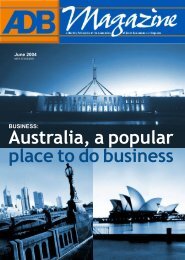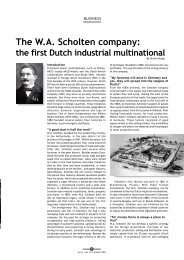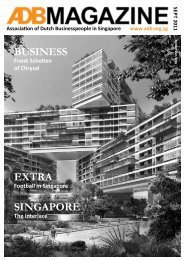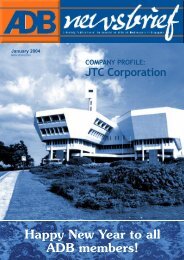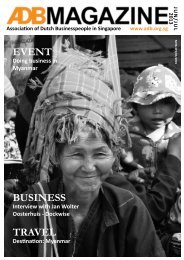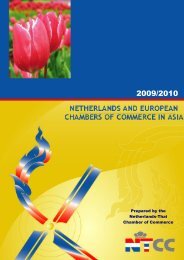(street) name? - Association of Dutch Businessmen
(street) name? - Association of Dutch Businessmen
(street) name? - Association of Dutch Businessmen
Create successful ePaper yourself
Turn your PDF publications into a flip-book with our unique Google optimized e-Paper software.
SINGAPORE<br />
What’s in a (<strong>street</strong>) <strong>name</strong> – Part II<br />
By Barry Doesburg<br />
In ADB Magazine <strong>of</strong> March 2005 we learned about<br />
the lives <strong>of</strong> Jose d’Almeida (1784-1850), George<br />
Drumgold Coleman (1795-1844), Tan Tock Seng<br />
(1798-1850), Lord Louis Mountbatten (1900-1979),<br />
‘Whampoa’ Hoo Ah Kay (1816-1880) and Ahmad<br />
Ibrahim (1927-1962). They all have in common that<br />
they are significant to Singapore history and that<br />
<strong>street</strong> <strong>name</strong>s have been <strong>name</strong>d after them. In this<br />
issue we will touch on a few other <strong>name</strong>s <strong>of</strong> famous<br />
Singaporeans.<br />
Cecil Street / Clementi<br />
Avenue<br />
Cecil Street and Clementi Avenue are<br />
<strong>name</strong>d after Sir Cecil Clementi Smith<br />
(1840-1916). He was Lieutenant Governor<br />
<strong>of</strong> Ceylon before being appointed Governor<br />
<strong>of</strong> the Straits Settlements from 1887 to<br />
1893. He was educated at St Paul’s School<br />
and Corpus Christi Cambridge, and in 1862<br />
he was elected one <strong>of</strong> the first student<br />
interpreters at Hong Kong, where he<br />
became colonial Treasurer. In 1878 he was<br />
transferred to the Straits settlements as<br />
Colonial Secretary and became Governor<br />
in 1887. He also succeeded in putting<br />
down several Chinese secret societies in<br />
the Straits Settlements, such as those in<br />
Singapore, for which he received the<br />
gratitude <strong>of</strong> the merchants that traded in<br />
the region. Later he became president <strong>of</strong><br />
the commission <strong>of</strong> Inquiry on the Trinidad<br />
riots in 1903 and was chief British delegate at<br />
International Opium Commission Shanghai in 1909.<br />
Cecil Street was built on reclaimed land carried<br />
out under Telok Ayer Reclamation project between<br />
1879 and 1888. Clementi Avenue (formerly<br />
Reformatory Road, because <strong>of</strong> a boys’ home) was<br />
located in the New Town that was developed on<br />
land once occupied by squatters and the British<br />
armed forces barracks.<br />
Napier Road / Tanglin Road<br />
Napier Road is <strong>name</strong>d after William ‘Royal Billy’<br />
Napier (b. 1804), the first lawyer in Singapore in<br />
1833. He arrived in Singapore in 1831 and married<br />
George Coleman’s widow, Maria Frances. Napier<br />
Road originally led to his house (‘Tang Leng’), which<br />
he built in 1854 on 27 ha <strong>of</strong> hilly land. He was one<br />
<strong>of</strong> the founders <strong>of</strong> the Singapore Free Press and a<br />
shareholder <strong>of</strong> the Raffles Library. Later he became<br />
the Lieutenant Governor <strong>of</strong> Labuan (Borneo’s<br />
northern coast) because <strong>of</strong> his friendship with Sir<br />
James Brooke.<br />
6<br />
Vol.16 • No. 5 • June 2006<br />
Tanglin/Napier Road in the 1880s<br />
Tanglin Road got its <strong>name</strong> from Napier’s house.<br />
The house was probably <strong>name</strong>d after the Chinese<br />
twa tang leng, which means ‘great east hill peaks’.<br />
After Raffles’ allotment in 1822, the Chinese,<br />
mainly Teochews, ventured out <strong>of</strong> Chinatown and<br />
colonized the tiger infested Tanglin area, growing<br />
pepper, nutmeg and gambier. After the Chinese<br />
came the Europeans, mainly Scotsmen, who started<br />
their spice plantations and built bungalows and<br />
villas on the various hills. Still many Scottish<br />
personal and place <strong>name</strong>s are featured in the area:<br />
Balmoral (Queen Victoria’s favorite residence in<br />
Scotland), Edinburgh, Claymore (house owned by<br />
Captain Scott), Cluny and Scott. Another one is<br />
Tyersall, William Napier’s estate and house in the<br />
Tanglin area which covered sixty-seven acres <strong>of</strong><br />
land was built in 1854 and later replaced by New<br />
Tyersall (or Istana Tyersall), the palatial Singapore<br />
residence <strong>of</strong> Sultan Abu Bakar <strong>of</strong> Johor.<br />
Tyersall Istana (http://www.baum.com.au)<br />
Oxley Road / Killiney Road<br />
Oxley Road is <strong>name</strong>d after the Irish surgeon Dr.<br />
Thomas Oxley (1805-1886), who lived on his nutmeg<br />
plantation in the area bounded by River Valley,<br />
Tank, Orchard and Grange Roads. Oxley came to<br />
Singapore in 1830 from Penang and was the Senior<br />
Surgeon for the Straits Settlements in 1844. He



